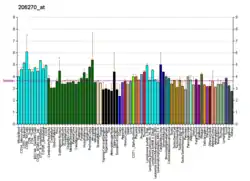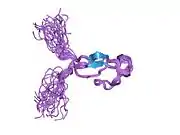PRKCG
Protein kinase C gamma type is an enzyme that in humans is encoded by the PRKCG gene.[4][5]
Protein kinase C (PKC) is a family of serine- and threonine-specific protein kinases that can be activated by calcium and second messenger diacylglycerol. PKC family members phosphorylate a wide variety of protein targets and are known to be involved in diverse cellular signaling pathways. PKC also serve as major receptors for phorbol esters, a class of tumor promoters. Each member of the PKC family has a specific expression profile and is believed to play distinct roles in cells. The protein encoded by this gene is one of the PKC family members. This protein kinase is expressed solely in the brain and spinal cord and its localization is restricted to neurons. It has been demonstrated that several neuronal functions, including long term potentiation (LTP) and long term depression (LTD), specifically require this kinase. Knockout studies in mice also suggest that this kinase may be involved in neuropathic pain development. Defects in this protein have been associated with neurodegenerative disorder spinocerebellar ataxia-14 (SCA14).[6]
See also
References
- GRCh38: Ensembl release 89: ENSG00000126583 - Ensembl, May 2017
- "Human PubMed Reference:". National Center for Biotechnology Information, U.S. National Library of Medicine.
- "Mouse PubMed Reference:". National Center for Biotechnology Information, U.S. National Library of Medicine.
- Trask B, Fertitta A, Christensen M, Youngblom J, Bergmann A, Copeland A, de Jong P, Mohrenweiser H, Olsen A, Carrano A, et al. (Mar 1993). "Fluorescence in situ hybridization mapping of human chromosome 19: cytogenetic band location of 540 cosmids and 70 genes or DNA markers". Genomics. 15 (1): 133–45. doi:10.1006/geno.1993.1021. PMID 8432525.
- Coussens L, Parker PJ, Rhee L, Yang-Feng TL, Chen E, Waterfield MD, Francke U, Ullrich A (Sep 1986). "Multiple, distinct forms of bovine and human protein kinase C suggest diversity in cellular signaling pathways". Science. 233 (4766): 859–66. Bibcode:1986Sci...233..859C. doi:10.1126/science.3755548. PMID 3755548.
- "Entrez Gene: PRKCG protein kinase C, gamma".
- Correia, Susana Santos; Duarte Carlos Bandeira; Faro Carlos José; Pires Euclides Vieira; Carvalho Ana Luísa (Feb 2003). "Protein kinase C gamma associates directly with the GluR4 alpha-amino-3-hydroxy-5-methyl-4-isoxazole propionate receptor subunit. Effect on receptor phosphorylation". J. Biol. Chem. United States. 278 (8): 6307–13. doi:10.1074/jbc.M205587200. ISSN 0021-9258. PMID 12471040.
Further reading
- Ali A, Hoeflich KP, Woodgett JR (2002). "Glycogen synthase kinase-3: properties, functions, and regulation". Chem. Rev. 101 (8): 2527–40. doi:10.1021/cr000110o. PMID 11749387.
- Slater SJ, Ho C, Stubbs CD (2003). "The use of fluorescent phorbol esters in studies of protein kinase C-membrane interactions". Chem. Phys. Lipids. 116 (1–2): 75–91. doi:10.1016/S0009-3084(02)00021-X. PMID 12093536.
- Saito N, Shirai Y (2003). "Protein kinase C gamma (PKC gamma): function of neuron specific isotype". J. Biochem. 132 (5): 683–7. doi:10.1093/oxfordjournals.jbchem.a003274. PMID 12417016.






